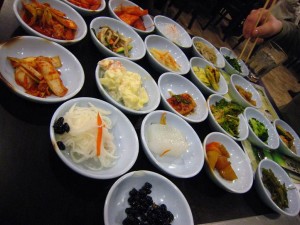Korean Food and YOU
by Sharon -- April 23, 2010
Korea is generally called a “homogenous” country, meaning that its natives are of the same blood. In Sharon terms, it means that everyone looks the same and if you don’t look like them you stand out. Keep in mind that I don’t mean to say this as a bad thing. In actuality, it’s something that I think is extremely interesting coming from the melting pot that is America.
One characteristic of homogenous countries such as Korea, China and Japan that highly differs from a country like the United States is the culture of dining out. (I’m going to assume Japan also possesses these characteristics, but if I’m wrong, I’ll find out soon enough). If you live in America, think about any time in your life where you’ve had to decide where to eat lunch or dinner. Unless you’re an obsessively picky eater or you have food allergies to… everything, I would bet that every single example involves deciding what type of food to eat, in terms of country origin. Italian, Chinese, Korean, Mexican, Japanese, Indian, and even “American” are some examples of food types that are everyday dining choices.
On the other hand, in places such as Korea where almost every native is a full-blooded Korean, people go out to eat at…. Korean restaurants! Obviously I’m not making a general statement about ALL Korean people, but so far I would say that the number of Korean restaurants to foreign restaurants dominates at an approximate ratio of 20:1 (the word approximate being VERY approximate, due to the fact that I am about as much of a mathematician as Kim Jong Il is a humanitarian). When Koreans go out to eat, they go to Korean restaurants! Not that I blame them, as Korean food is some of the best and healthiest food ever…
… Which leads me to my next segment of this post: What the hell is Korean food?
I have been asked the question “what is Korean food?” many times in my life. The problem is that I never have an answer prepared because all I can think of is to explain what Kimchi is. For those of you who have never had Korean food, here is my best shot at explaining an entire culture’s food:
- My sister recently said that Korean cooking is generally comprised of just a few main ingredients: Garlic, crushed red chili pepper, green onions, soy sauce, doenjang (fermented soy bean paste used to make stews, soups, etc), and gochujang (fermented red chili pepper paste). Of course, these ingredients are only used for creating basic flavors and are always accompanied by vegetables, meat, tofu, and/or seafood.
- Korean food is generally spicier than most foods. The main ingredient
 in many spicy Korean foods is ground red chili pepper. Kimchi is the most familiar dish of Korea but it’s actually just a side dish that you eat along with your meal. There are many dishes that do use kimchi as the main ingredient, though.
in many spicy Korean foods is ground red chili pepper. Kimchi is the most familiar dish of Korea but it’s actually just a side dish that you eat along with your meal. There are many dishes that do use kimchi as the main ingredient, though. - Korean food is generally very healthy. Many of its dishes are simply comprised of tons of vegetables and some meat, as well as tofu and seafood. The un-healthy part of Korean food, however, is the amount of sodium in a lot of dishes. Korean food consists of many soups and stews, not to mention Korean BBQ marinade. These soups usually have tons of “beef stock” which is very salty. Also, they eat a lot of rice, almost with every meal. Rice isn’t exactly nutritious, although it’s certainly better than eating a burger.
- Korean BBQ is the most famous of all Korean foods and is usually the
 only thing that foreigners have had that is Korean. It is usually cooked on a grill at your table which is not only fun but you can be sure that it doesn’t involve any unnecessary oils or fats. Basically, it is the most delicious meat you’ll ever eat in your life. The end.
only thing that foreigners have had that is Korean. It is usually cooked on a grill at your table which is not only fun but you can be sure that it doesn’t involve any unnecessary oils or fats. Basically, it is the most delicious meat you’ll ever eat in your life. The end. - Korean food also consists of many types of soups and stews, which are
 called “gook” (I know, it sounds terrible) or “jjigae” in Korean. They generally contain tons of vegetables, sometimes noodles, sometimes Korean dumplings (called “mandu”) and chewy rice cakes called “tteok” or “duck” for American accents. These are served in hot clay pots and the soups are usually still boiling when it gets to your table. A raw egg is sometimes added to the boiling soup at the table so that it cooks before you eat it.
called “gook” (I know, it sounds terrible) or “jjigae” in Korean. They generally contain tons of vegetables, sometimes noodles, sometimes Korean dumplings (called “mandu”) and chewy rice cakes called “tteok” or “duck” for American accents. These are served in hot clay pots and the soups are usually still boiling when it gets to your table. A raw egg is sometimes added to the boiling soup at the table so that it cooks before you eat it. - Some Korean side dishes or main courses are considered “stinky” by foreigners. I don’t blame these foreigners, Korean food such as “doenjang jjigae” can have a strong smell but is very delish (doenjang is fermented soy beans and is the basis for Miso Soup that they serve at Japanese restaurants).
- Koreans eat a lot of fish.
- At Korean restaurants you will be served a variety of side dishes called
 “banchan” that are served in little bowls and are brought out before the main course. Jason and I enjoy rating a restaurant based on how good their side dishes are.
“banchan” that are served in little bowls and are brought out before the main course. Jason and I enjoy rating a restaurant based on how good their side dishes are.
Although this is by no means an exhaustive list of Korean food characteristics, it is a start for anyone who is not familiar with Korean food. Even Jason has come to absolutely love Korean food, including Kimchi! Yes, Korean food is a bit different from the familiar sushi or Kung Pao Chicken that you are all used to, but going to Korean restaurants is fun in itself. Finding out which side dishes you’re going to get, cooking your food at the table, and trying to get something that is not dog meat (just kidding) is always fun!
Random Thought of the Day: My favorite website nowadays happens to be a Korean cooking blog that is written by a Korean-American living in Oakland. I have gotten numerous recipes from it and she even throws in some Korean food education into the blog! Check it out!
Be awesome and help us share:


[...] we just try speaking to them in English for an hour until they go to dinner. Last week we made Tteokbokki, though, which was really fun. I ended up getting some good tips! Hopefully we’ll start doing [...]
[...] Korean ladies cook you some authentic home-made Korean food. I even perfected my own version of Tteokbokki, which is honestly the best I’ve ever [...]